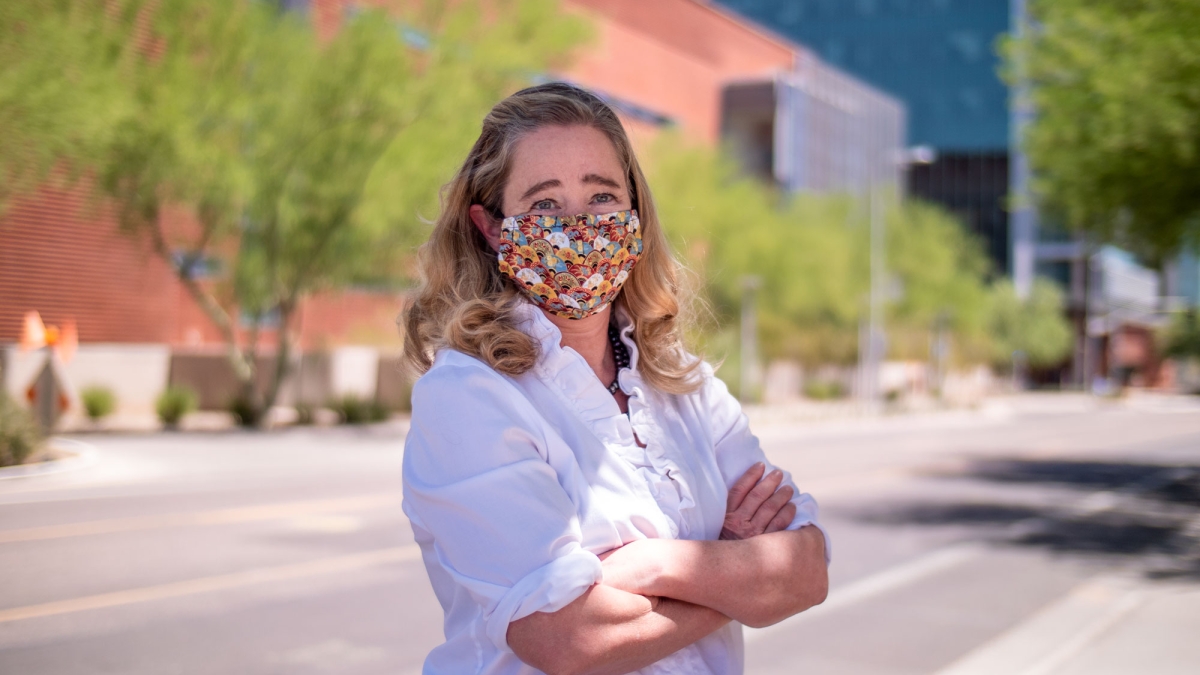ASU psychology researcher creates game to promote understanding of how COVID-19 spreads

Mina Johnson-Glenberg, a research scientist in the Arizona State University Department of Psychology, created a web-based and augmented reality COVID-19 Modeling Simulation to create an engaging way to teach people how the virus spreads and ways to reduce transmission.
The COVID-19 pandemic has led to widespread unemployment, remote working, school closures, business closures and overwhelmed health care systems.
Mina Johnson-Glenberg, a research scientist in the Arizona State University Department of Psychology, created a web-based and augmented reality COVID-19 Modeling Simulation to create an engaging way to teach people how the virus spreads and ways to reduce transmission.
“I’ve been creating simulations to teach STEM content for over a decade, and now that the technology has become more widely available, we have been taking what we know about two-dimensional content and transforming it for 3D,” Johnson-Glenberg said. “The lab turned this model into a public safety announcement to show the general public how COVID spreads. Users can space people out various distances and then put masks on certain avatars to see how those actions reduce the spread as well.”
Johnson-Glenberg’s Embodied Games Lab recently won an XR Challenge award for creating a visualization model to demonstrate the spread of another infectious disease — Ebola. The team pivoted to work on the COVID-19 simulation to show the effects of physical distance between avatars and how effective wearing a mask can be. Once the user has defined the physical spacing and whether or not the game’s character is wearing a mask, they can see what happens in either a 2D or 3D scenario.
“Wearing masks and keeping a distance is so important, and we think this game will help people internalize that message even more,” Johnson-Glenberg said. “This tool is extremely useful for people who may not understand how something like COVID spreads. We thought teachers and families would particularly benefit from this interactive simulation.”
To reduce transmission, the CDC recommends physical distancing of 6 feet and wearing a cloth face covering, in addition to regular hand washing and sanitizing of high-touch surfaces.
Mina Johnson-Glenberg uses augmented and virtual reality to highlight the importance of social distancing and mask-wearing during the COVID-19 epidemic.
For anyone who would like to play the alpha version of the game, click this link. (iOS not available yet.)
Aggregating COVID-19 visualization research
Johnson-Glenberg is also the co-editor of a special issue of Frontiers in Psychology for those who have created compelling COVID simulations. The issue is still open for short papers, and the publication fee is waived until December 2020. Topics include using simulations and interactive visualization as teaching tools in education; theoretical modeling; using augmented, mixed or virtual reality (XR) in simulations of COVID-19; and concepts about simulations and visualization techniques.
“I thought it would be useful to pull together some of the best simulation research related to COVID-19 from countries around the world and to collate it all in one place. Thankfully, Frontiers agreed, and also Dr. Megan Jehn at SHESCThe School of Human Evolution and Social Change at ASU. consented to be a co-editor,” Johnson-Glenberg said.
Future of education in virtual and augmented reality group
Students and faculty who are interested in virtual and augmented reality (also called XR), including simulations and games for the general public, are encouraged to join the chair, Johnson-Glenberg and colleagues at the FEVAR monthly meetup, starting again in September 2020.
Also, Johnson-Glenberg is an invited speaker presenting on Embodied Learning and the differences in 3D VR compared with 2D PC at the Immersive Learning Research Network. The session is on June 24 at 7 p.m. PST. Free tickets are available.
For the latest ASU-specific COVID-19 guidelines, visit: https://eoss.asu.edu/health/announcements/coronavirus.
More Science and technology

The science behind chronic stress
Stress comes in many shapes and sizes. There’s the everyday stress of preparing for a final exam or being stuck in traffic. And…

ASU planetary scientist to be inducted into the National Academy of Sciences
The National Academy of Sciences is inducting School of Earth and Space Exploration Director Meenakshi Wadhwa into the 2023 class…

Unlocking the potential of AI for homeland security
“Can we do what we're doing now cheaper, more efficiently, more effectively?” Adam Cox, director in the Office of Strategy and…